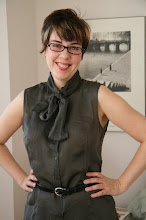On the one hand, the materials I've purchased are of good quality, and I have just about every sort of interfacing known to man. On the other hand, the Burda jacket is of an entirely different style. It's softer-looking than the Claire Schaeffer jacket, at least to my eye.
I don't want to use crisp interfacing and underlining just for its own sake, and because I love the process of hand tailoring. I also don't know if I'd be better off hand-working the buttonholes with silk twist and gimp (I've bought both at great expense), or by just using a machine. On the topic of the machine: I've had numerous good experiences with my vintage Singer on this account (it's the only thing the machine actually does well, probably cuz it needs a recalibration, the likes of which my husband and I are unable to undertake ourselves). I mean, I've machine buttonholed numerous sweaters at this point - at the very final moment after having spent weeks on them. So I do trust the Singer. But machine buttonholes, after a very bad experience that torched an entire project, are scary to me. The one option has me learning a new skill (perilous, I suppose). The other has me machining into my finished jacket at the last minute. At least with the hand-worked buttonholes, I will have practiced, it will go slowly and I'll be slightly more in control, she says knowing, um, nothing.
Observe my interfacing options:
From left to right, that's hymo (hair canvas), silk organza, weft interfacing and another weight of weft interfacing (I think that's what those last two are called but, in truth, the interfacing is harder to identify than to use. The first 2 are sewn in. The second two are fusible.
Here's another quick shot of my fashion fabric and lining (in case you've forgotten about them):
I'm ticked that these fabrics look wan and inaccurate in photos. In real life, the slate blue of the fashion fabric is mesmerizing. And the celery-shade of charmeuse is an excellent complement.
In order to keep it all straight (Lord knows Burda "instructions" don't give you any means by which to organize yourself), I've written lots of notes, amongst them all of the fabrics I've got to cut out (by pieces) and ways to prep those fabrics:
 |
| These notes go on for pages - didn't want to traumatize you... |
BTW, I took this great pic of all the re-traced (clean and beautiful) pattern pieces (including the ones I had to make from scratch cuz Burda doesn't provide them: facings, interfacings, stay, lining - when distinct from the pattern pieces) and then my computer ate it. Fuck. There is no way I'm setting them up again today for another shot. There are like a zillion of them.
Um, talk about burying the lead. I finished the final muslin yesterday afternoon. I returned to the original muslin's sleeves which were much closer to what I needed than the ones I spent hours creating on muslin 3. I did some more tweaking (namely taking lots of height out of the sleeve cap) and decided to call it a day. Is it perfect? Only time will tell. The front armscye is going to be interesting because I ended up needing more fabric there than I'd originally expected (to optimize motion). I altered the pattern pieces accordingly, but I'm not making another muslin. (I did leave more seam allowance in that area, just in case).
Intriguingly, I happened upon the one paragraph in Sarah Veblen's tome in which she urges one to know when it's time to stop fitting (at the risk of overfitting a test garment the properties of which are, needless to say, quite different from those of the fashion fabric). I took it as a sign.
Today I'm off to Hilary's for Easter dinner and tomorrow morning M and I are going for manicures and out for a pre-birthday lunch. I've opted to take Tuesday (M's birthday) and Wednesday as holiday days - in which to sew more - but I will have certain responsibilities and activities that will impinge on my being able to give it 12 hour blocks of time, as I have been able to for the past 2 days.
By Wed, I hope to:
- finalize where the buttons should go on the front
- get the fabric prepped
- get all of the pieces cut
- decide about what kind of tailoring I'll do
- fuse pieces (if that's what I opt to do)
- get set for the sewing (to start next weekend): check my machine and test fabric scraps with needles to ensure I know what my best stitch lengths and tension should be.
Exciting times, peeps.
So, today's questions: Do you think I should hand-tailor or use fusibles to tailor this jacket? Regardless of whether I use fusibles, do you think I should use my machine for buttonholes, or hand work them? (FYI, the pattern doesn't indicate what kind of interfacing to use, as far as I can tell. You have to look at tiny pictures simply to determine which pieces are to be interfaced at all! I'll be using my tailoring book to walk through the steps - be they hand-tailored or fusible.

























